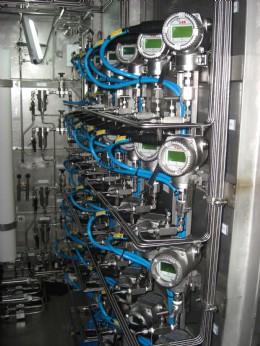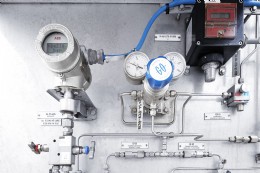A guide to pressure transmitter materials selection


ABB pressure transmitters

When selecting a material for a pressure transmitter it is necessary to consider both their resistance to corrosion and their suitability for the specific application in question. For example, the filling fluids used in a pressure transmitter mean that they cannot be used in direct contact applications such as in the food and beverage industry, as any leakage could corrupt the process.
Corrosion is a major challenge in many pressure measurement applications. Corrosion is the gradual destruction of a metal either by chemical or electrochemical means. The speed and aggression of corrosion can be determined by a variety of factors, ranging from different types and combinations of chemicals through to temperature, particularly in high temperature applications. For example, temperatures above 40°C (104°F) in seawater can increase the risk of corrosion of stainless steel components through pitting.
Where materials selection is concerned, it is important to remember that there is no ‘catch-all’ solution that will be suitable for all types of application and process conditions. With the onus sitting squarely on the user to make the right selection, it is therefore essential that you make a careful and detailed analysis of your process in order to correctly specify the materials for your device.
If in doubt, it is always best to consult a pressure measurement expert, who can suggest possible solutions.
The following section contains advice on some of the most common materials used for the wetted parts of pressure transmitters, these being the components that come into direct contact with the process.
316L Stainless steel
As the standard material for the wetted materials of ABB’s 2600T pressure transmitters, 316L SST offers good resistance against corrosion, including low concentrations of nitric acid and most salt solutions.
When it comes to alkaline solutions, organic acids and other organic compounds, the resistance of 316L SST against corrosion may depend on temperature. Certain halide salts, including fluorine, chlorine, bromine and iodine, can also cause severe pitting and stresscorrosion cracking.
For oil and gas applications, where hydrogen sulphide is often present, 316L SST may be available with specific NACE MR0175 certification. This standard defines the types of corrosion resistant materials that can be used in various oil and gas industry environments. As such, it covers most types of stainless steels, including 316L SST.
By setting criteria both for the hardness of the material and the process by which it is manufactured, the standard helps to reduce the risk of sulphide stress corrosion cracking. The standard also covers nonwetted parts such as bolts, as they also have a bearing on the instrument’s overall containment effectiveness even if they are exposed to corrosive environments far below the limits of the standard.
The NACE certificate is also available for other materials including Monel and Hastelloy C.
Monel
Monel offers good resistance against the corrosive effects of most of the non-oxidising acids, such as hydrofluoric, sulphuric and phosphoric acids, at ambient temperatures.
Monel is also considered the prime choice for applications where components are in contact with sea water. Despite its general high resistance to corrosion, Monel is not suitable for contact with acid and alkaline oxidising sales, which can cause severe corrosion damage.
Applications with a high hydrogen concentration may also affect Monel’s effectiveness as a material of construction. Especially where Monel is used as a diaphragm material in hydrogen gas processes, hydrogen atoms may permeate the diaphragm, leading to hydrogen bubbles forming within the fill fluid.
Hastelloy C
Hastelloy C is comprised of chromium and molybdenum added to nickel to improve the alloy’s resistance to oxidising conditions. As such, Hastelloy C is well suited for protecting against the rigours of alkalis, organic acids and other organic compounds.
Hastelloy C also offers good protection against oxidants such as phosphoric acid as well as acid salts including nickel and copper chlorides. At moderate temperatures, Hastelloy C is able to withstand hydrochloric and sulphuric acids in most concentrations. Like Monel, Hastelloy C also affords good protection against atmospheric conditions and fresh water.
Gold plated Hastelloy C, Monel or SST
Hastelloy C, Monel and SST can all be permeated by hydrogen, meaning that they should be avoided as a diaphragm material for use in applications where hydrogen is present. Hydrogen atoms can diffuse through the very thin transmitter diaphragms into the fill fluid, whereupon they can combine with the fluid to form molecular hydrogen. This is particularly a problem at elevated pressures and temperatures, which increase the permeation rate.
As molecular hydrogen is too large to permeate back through the diaphragm, it becomes trapped and forms bubbles in the fill fluid. As these bubbles form and accumulate, they can severely affect transmitter performance.
One way to prevent this problem is to plate the diaphragm with gold, which prevents hydrogen permeation at high process temperatures and pressures.
Another form of protection available from ABB is a corrosion resistant hydrogen preparation gel, which can be applied to a pressure transmitter’s diaphragm to reduce hydrogen permeation.
Tantalum
Tantalum is an ideal alternative to 316L SST in corrosive applications featuring a range of chemicals including hydrochloric, hydrobromic, boiling hydrochloric, nitric, phosphoric and sulphuric acids. It has a high melting point and good strength even at elevated temperatures.
With the exception of aluminium fluoride, potassium carbonate and sodium sulphide, to which Monel is more suited, Tantalum offers a good resistance to most acids, chemical solutions and organic compounds, as well as liquid metals.
Despite this, Tantalum can suffer severe embrittlement if used with high temperature oxygen or nitrogen, or with hydrogen at any temperature. It is also prone to attack by strong alkaline solutions and by fused alkalis such as sodium hydroxide.
PFA (Teflon from DuPont)
Used by ABB for its AISI 316 L SS remote seal transmitter, PFA (Teflon) coating offers outstanding protection against corrosion and anti-stick properties, with even a 0.2 to 0.3mm coating capable of providing a cost effective alternative to more expensive methods, such as the use of specialised materials.
A limitation of a PFA coating is its recommended temperature limit of 200°C (392°F) and a minimum increase of the temperature effect on accuracy. Also, if the diaphragm is subject to mechanical abrasion (rapid flows with solids) it can become punctured, allowing corrosion to penetrate the area below the coating.
Other points to consider
Aside from the materials of construction, there are also other factors that can affect the operation of a pressure transmitter.
One important aspect is the selection of the appropriate fill fluid. Making the correct choice is especially important as the type of fill fluid can limit the working temperature that the transmitter can stand.
For this reason, it is advisable to choose a fill fluid that can be used over the widest possible range of operating temperatures. The most widely used is Silicone Oil DC200, which offers high stability over temperatures ranging from -40°C to 200°C (-40°F to 392°F).
Alternatively, other fluids may be selected whenever their temperature range is compatible with the application, in order to take advantage of a lower viscosity or thermal expansion factor. This is especially useful where faster response times are required in remote seal applications with long capillaries.
In some applications, such as food and pharmaceutical production processes, it may also be undesirable for certain fill fluids to be used, in order to prevent potential product contamination caused by a ruptured diaphragm. Where this is the case, a food sanitary fill fluid should be selected.
An alternative fill fluid should also be used for transmitters used for oxygen rich applications , where leakage of a silicone oil fill fluid could cause a fire. For this reason, an inert fill fluid should be selected.
Another important aspect concerns the selection of the appropriate material for the transmitter gasket. The most widely used material is PTFE (Teflon), due to its general corrosion suitability with several materials. However, a potential drawback of PTFE arises in processes subject to periodic variations in temperature. Particularly in processes where the temperature varies by several degrees, the limited elasticity of PTFE can compromise its tightness. In these instances, it would be wise to consider the elastomer Viton.
Special requirements may also arise in food or pharmaceutical applications, which frequently call for an approved material listed by the US Food and Drug Administration (FDA) or other national equivalent organisations.
Summary
As one of the most ubiquitous process parameters, pressure measurement needs to be conducted across a wide range of operating environments and process conditions. Given the wide variety of pressure ranges and operating conditions, having a good understanding of how to specify a device can be a useful first step in ensuring it fully meets the requirements for a particular application.
With decades of experience in the design and manufacture of pressure measurement devices and systems, ABB can advise on all aspects of pressure transmitter selection.
ABB Ltd
Tel: 0870 600 6122
www.abb.co.uk

| Telephone: | 01480 4753221 |
| Email: | info@gb.abb.com |
| Website: | www.abb.co.uk/measurement |
| More information on the ABB Limited BVAA Member Directory Page |
Search related valve / actuator articles: ABB LimitedIssue 26Master Class







-web.jpg)





